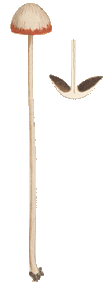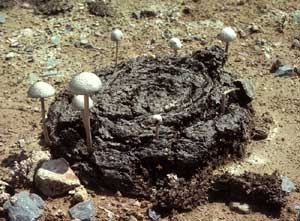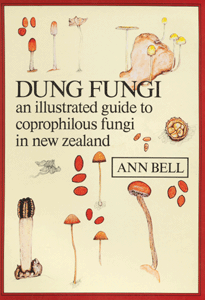 Fungal
ecology
Fungal
ecology
Dung fungi
Dung is another source of organic matter and a potential home for saprotrophs. From a fungal point of view, herbivore dung is the more interesting, since bacteria are largely responsible for the breakdown of carnivore and omnivore dung. Herbivore dung supports a wide variety of coprophilous fungi. The word coprophilous literally means "dung loving".
Herbivore dung typically contains plant material digested to varying extents.
This photo of a species of Cheilymenia ![]() shows the bright orange, discoid fruiting bodies (each between 1 and 2 mm in
diameter) but you can also see some partially digested plant material. Cheilymenia
is an ascomycete and several species of this genus are found in Australia. Poronia
erici
shows the bright orange, discoid fruiting bodies (each between 1 and 2 mm in
diameter) but you can also see some partially digested plant material. Cheilymenia
is an ascomycete and several species of this genus are found in Australia. Poronia
erici ![]() is another coprophilous ascomycete.
is another coprophilous ascomycete.
Cyathus stercoreus ![]() is a basidiomycete, widespread in Australia as well as being found
in many other countries. In this photo it is shown on cow dung in a watercourse
on Norfolk Island. While often found on dung, Cyathus stercoreus also
grows in rich soil. There are also various mushroom-producing coprophilous species
– especially in the genera Coprinus, Panaeolus and Psilocybe.
This photo
is a basidiomycete, widespread in Australia as well as being found
in many other countries. In this photo it is shown on cow dung in a watercourse
on Norfolk Island. While often found on dung, Cyathus stercoreus also
grows in rich soil. There are also various mushroom-producing coprophilous species
– especially in the genera Coprinus, Panaeolus and Psilocybe.
This photo ![]() shows a few Psilocybe mushrooms growing from dung
balls.
shows a few Psilocybe mushrooms growing from dung
balls.
 Panaeolos sp. on buffalo dung |
If you incubate a dung sample and observe it for many weeks you will see a sequence of fruiting bodies appearing on it. Some people may refer to this as a succession of fungi appearing on the dung and make analogies with a plant succession in a disturbed area. First come the pioneering plants and these are later displaced by other species as fresh seeds arrive or as buried seeds germinate.
One thing to be very careful of when talking about fungal succession is that the visible fruiting bodies are not the whole story. There are the mycelia, out of sight inside the dung, and the visible sequence of fruiting bodies need not reflect a similar sequence of fungal colonization of the dung. If the fruiting bodies of a particular fungus appear a couple of months after the dung was dropped, is it because the spores of that particular fungus only arrived later? Or was the mycelium of that fungus present early on, but needing a long time to build up the mass necessary for the production of fruiting bodies? If the mycelium was present fairly early, along with the mycelia of other species, you can certainly talk about fruiting body succession, but there has been no fungal succession.
The spores of many dung fungi are on the dung at the time it is dropped by an animal, for the animal will have swallowed many fungal spores in the course of feeding. Once released from their dung-inhabiting fruiting bodies, the spores of many dung fungi end up falling onto grass and leaves. Many species of dung fungi have spores with thick walls, which weaken during passage through an animal’s gut and so ready the spores for germination, once they have been deposited with the animal’s droppings.
At the time the dung drops to the ground there are likely to be a number of fungal species with spores ready to germinate. Many of these germinate at much the same time but the mycelia then grow at varying speeds. Thus, in some cases the sequence of fruiting body appearances reflects the speed of mycelial growth, and how quickly a mycelium can accumulate enough resources to allow the production of fruiting bodies. Some dung fungi, though slow growing, are very antagonistic to other species and able to destroy or severely inhibit other mycelia.
 |
Of course there can be a fungal succession - some spores may germinate later, spores from elsewhere may land on the dung and then germinate and grow there or mycelia from elsewhere may move into the dung. As well as fungi various bacteria, nematodes, mites and flies also make use of dung and in the wild the moisture content of the dung may fluctuate. All in all, dung is a complex environment and the interactions between all these organisms (and the weather) will also influence the appearance of fruiting bodies.
Two excellent sources of information are Ann Bell's books Dung Fungi: an illustrated guide to coprophilous fungi in New Zealand (published by Victoria University Press, 1983) and An illustrated guide to the coprophilous Ascomycetes of Australia (published by Centraalbureau voor Schimmelcultures, Utrecht, in 2005). The covers are shown here. The cover of the earlier book shows several of Ann's paintings of dung fungi and within the book you will find many more. Despite the title the book is highly useful in Australia. The main picture on the other cover shows a photograph of two asci (one spore-filled) of Ascobolus quezelii and within the book there are more photographs as well as many paintings and drawings.
![An Australian Government Initiative [logo]](/images/austgovt_brown_90px.gif)

